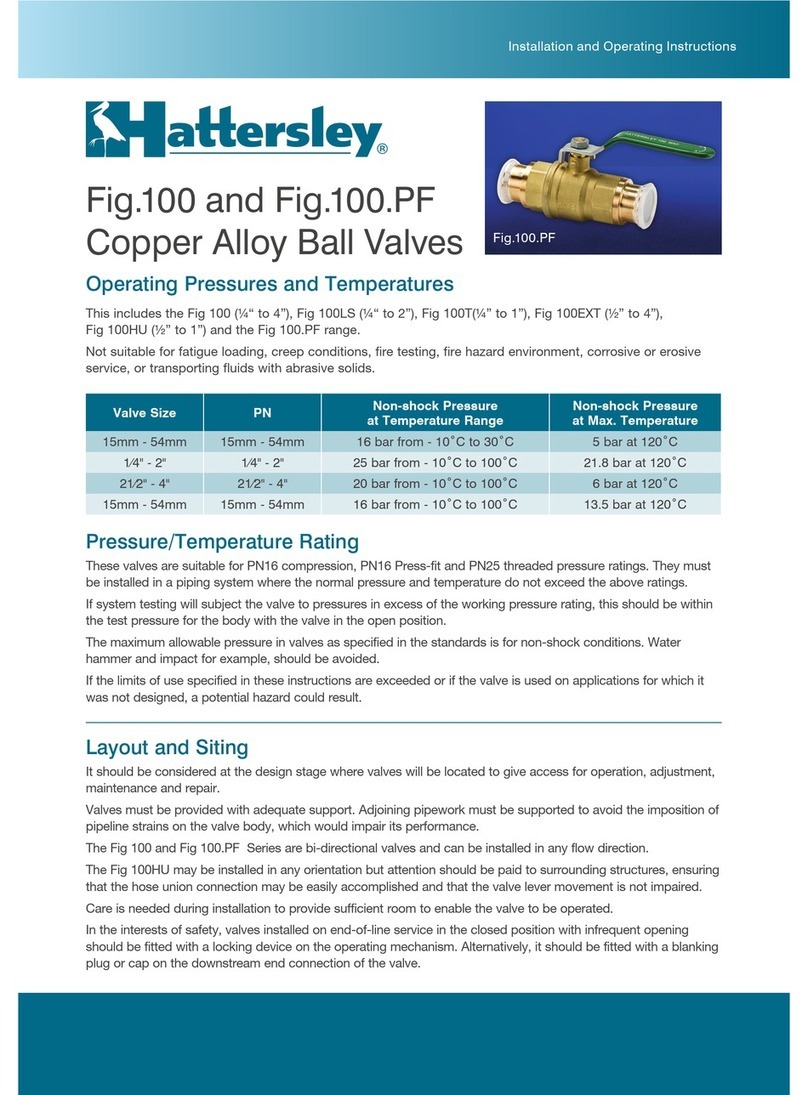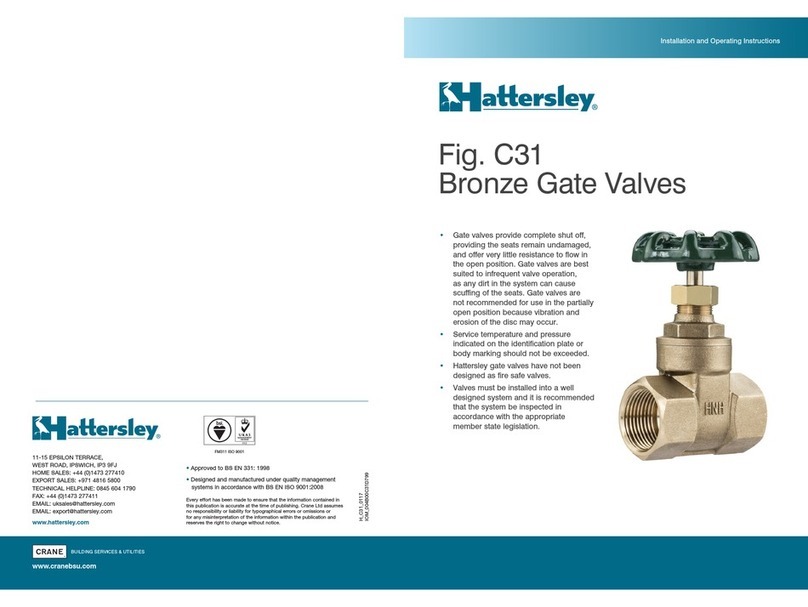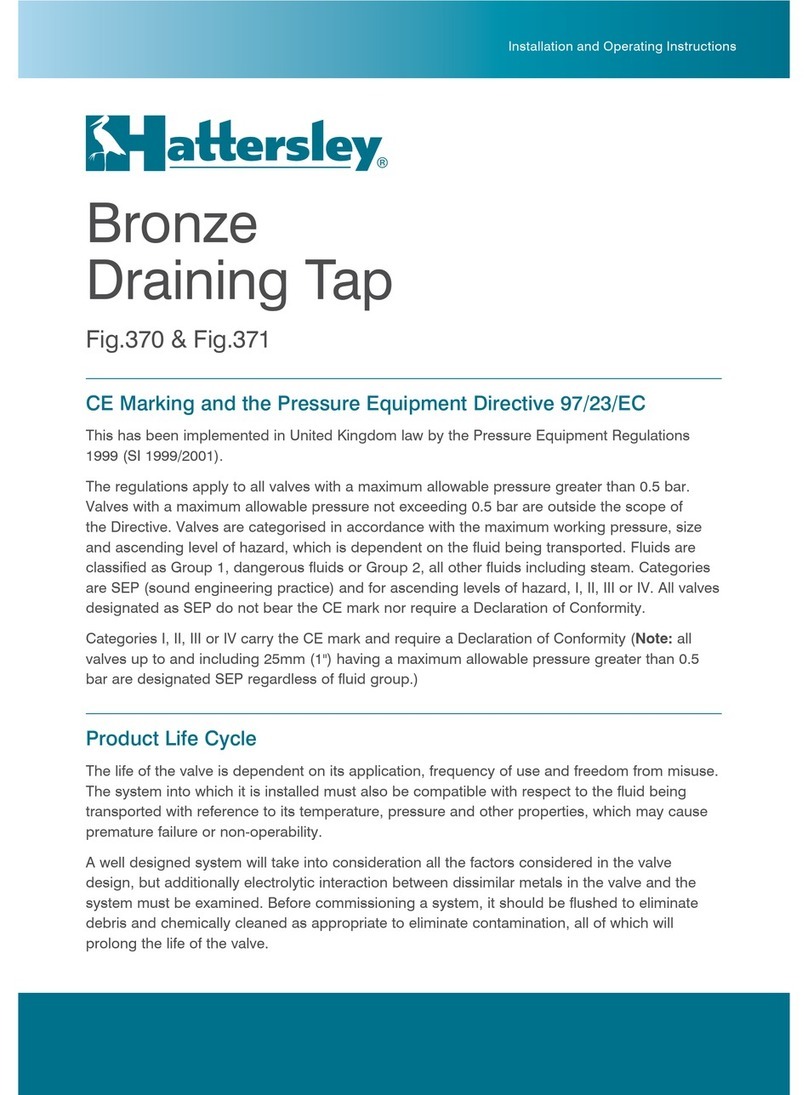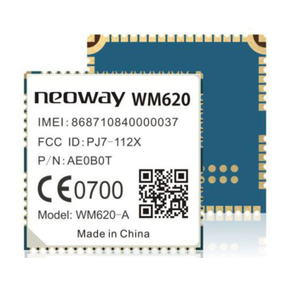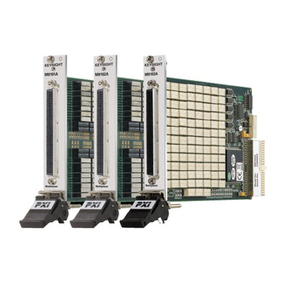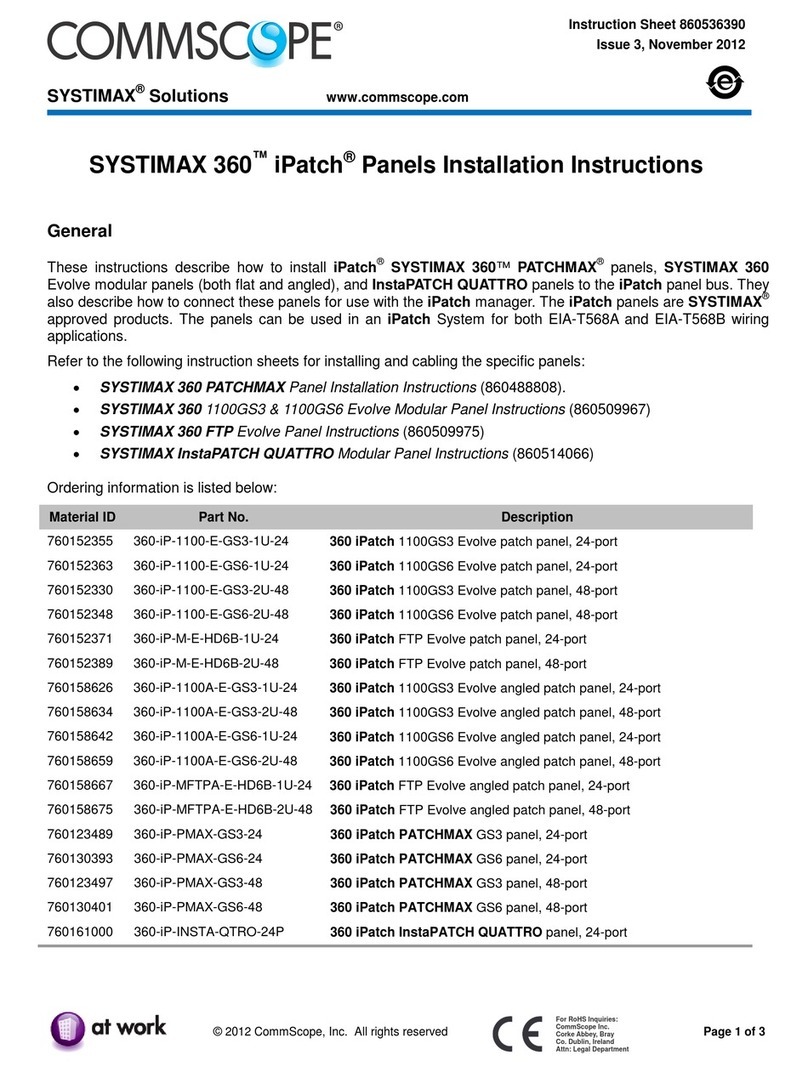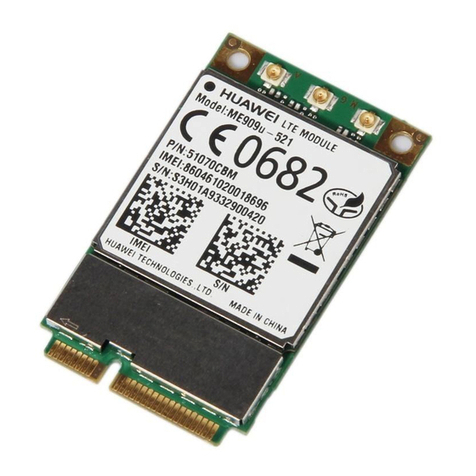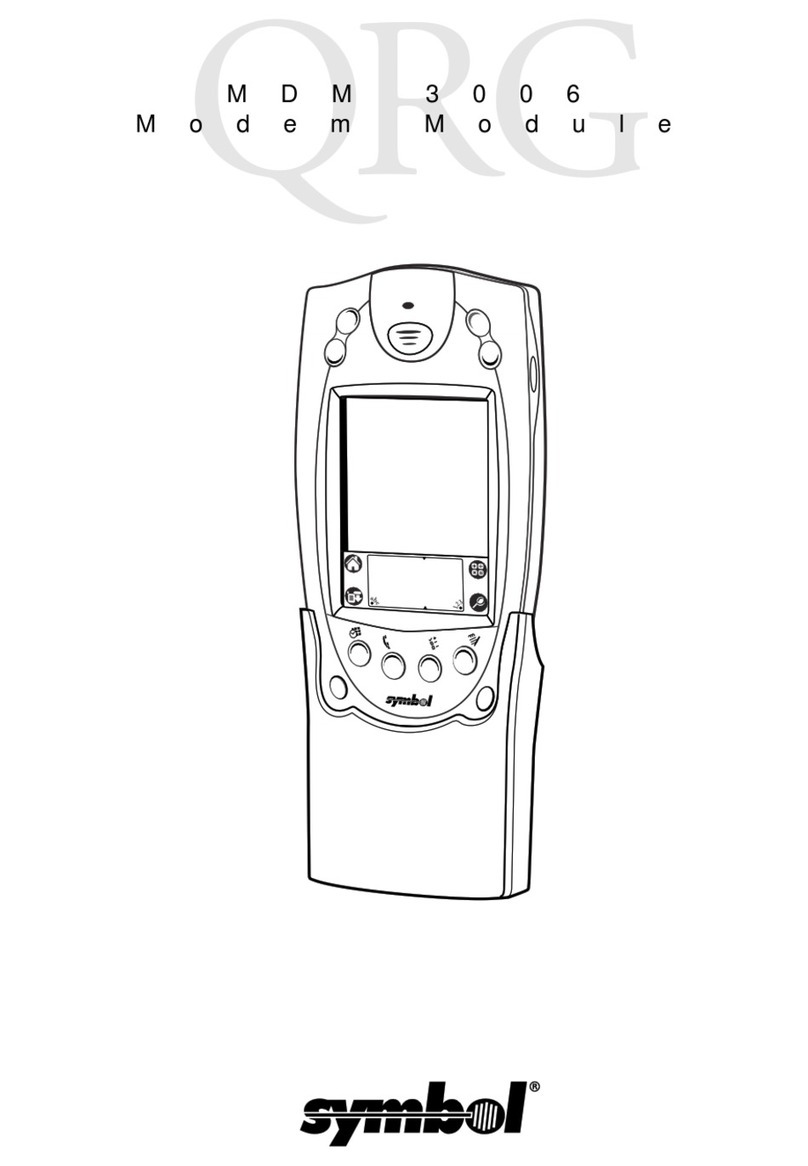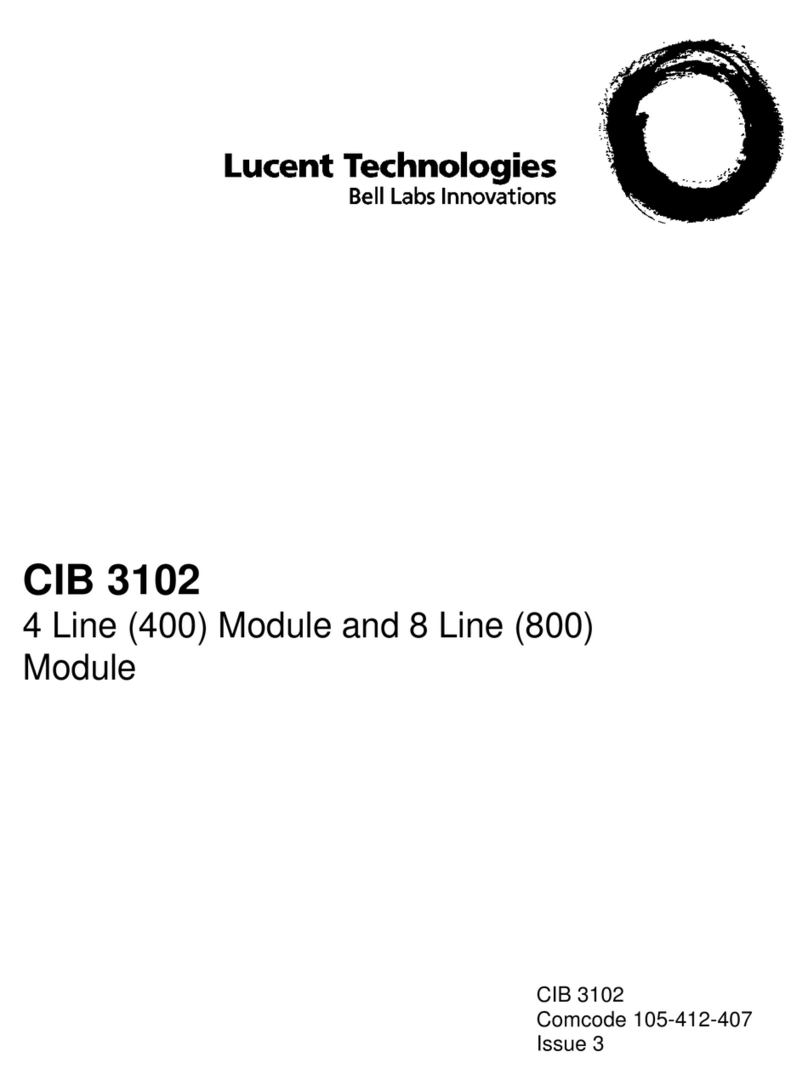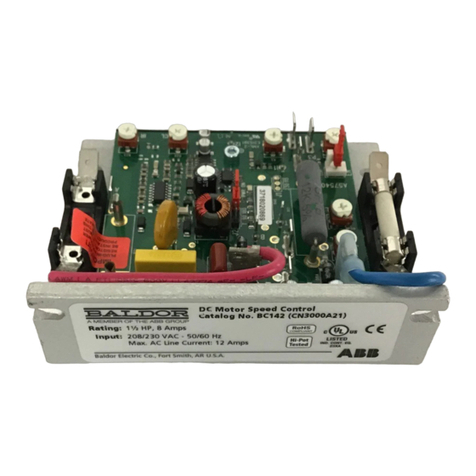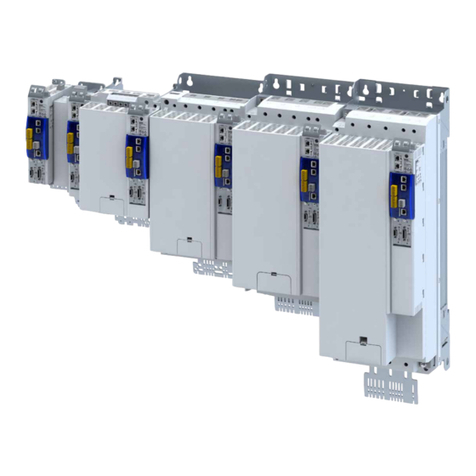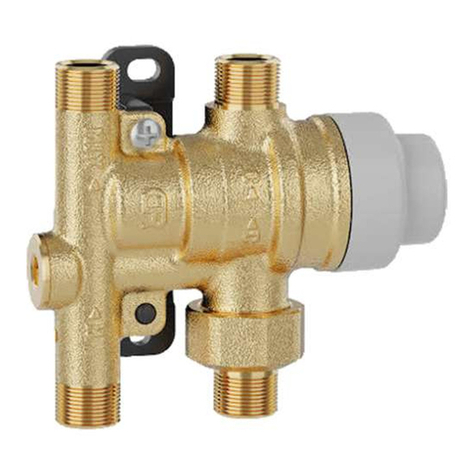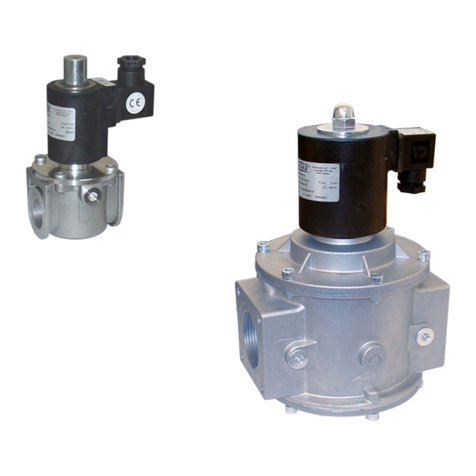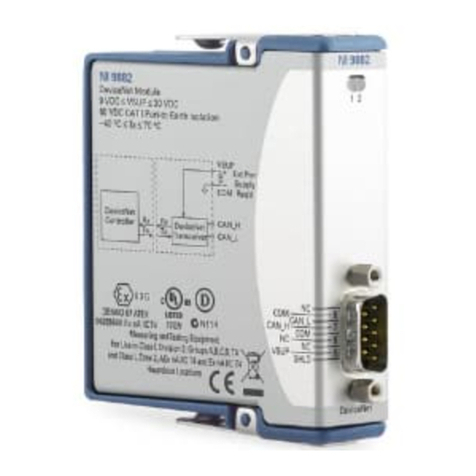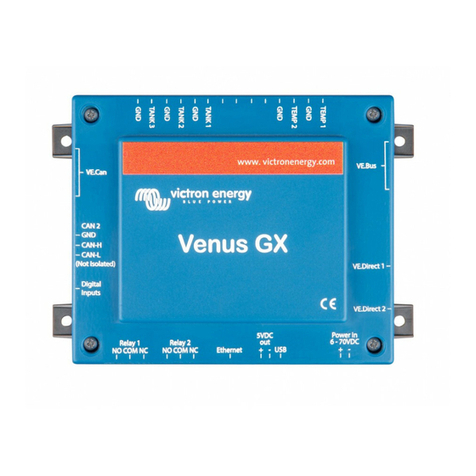Hattersley 1934 PICV Quick start guide

Pressure Independent
Control Valve (PICV)
General Notes
The Hatterley Fig. 1934 PICV;
• can be used in variable volume heating and
chilled water systems
• provides modulating control for terminal units
when installed with a modulating actuator
• has an equal percentage control characteristic
at all pre-set flow rates with actuator
• has built in Differential Pressure Control
• has an operating temperature: 0 to 90˚C
• has a maximum working ∆P of 400kPa
• has a maximum operating pressure of 25 bar
• Integral test points for verification of ∆P and
valve performance
PICV Fig. 1934
MIDDLE EAST & NORTH AFRICA
SALES OFFICE,
BUILDING 4, OFFICE 901,
THE GALLERIES, PO BOX 17415,
DOWNTOWN JEBEL ALI
DUBAI, UAE
TELEPHONE: 5800 816 4(0) 971+
EXPORT SALES ENQUIRES:
Installation and Operating Instructions

Limits OfUse
These valves have been categorised in accordance with the Pressure
Equipment Directive–PED.
The fluid to be transported is limited to group 2 liquids i.e. non-hazardous.
On no account must these valves be used on any group 1 liquids, group 1
gases or group 2 gases.
Installation
These instructions are issued as guidelines only and do not cover all installed
conditions. If unsure, please contact our Technical Helpline before installation.
• Hattersley products are designed for installation and use within suitably
designed systems reflecting CIBSE, BSRIA and HVAC guidelines. Particular
care should be taking with regards to;
-accessibility to valve for setting/adjustment
-tube cutting
-jointing
-bracketing/supports
• orientation: whilst the PICV can operate correctly in different orientations,
there are recommendations regarding the orientation of actuators - Please refer
to separate actuator IOM
• would normally be installed on return pipework, i.e. after the equipment it is
controlling, but can be installed in flow if required.
• ensure direction of flow is correct - indicated by cast arrow on body.
• Fig. 1934 operates between a minimum and maximum pressure drop across
the valve - see commissioning.
• PICV’s are not designed as isolation valves. Dedicated isolation valves
should be installed to isolate against system pressure, i.e. for maintenance
etc., when disconnecting/draining pipework.
• systems should be installed with strainers to protect the PICV and other
installed items.
Hattersley – Pressure Independent Control Valve – Fig. 1934
Installation and Operating Instructions

Flushing
Control valves, like the PICV, are sized to give good control over the system
flow, therefore have been designed with small convoluted flow paths. Even
when fully open these flow paths may not allow adequate water velocities for
flushing of the coil. In line with BSRIA recommendations, it is recommended
that a flushing point be located between the coil and the PICV. This allows
the coil to be flushed without the water passing through the PICV. As per the
Hook-Up Elite Prime range.
Installation Cont.
Please note this valve must not be used for end of line service or as an
isolation valve. In order for the valve to function as intended water quality
should be maintained at all times (e.g. as per BSRIA BG50 or equivalent).
Set Position
The PICV set position can be established by
use of lookup table on page 5
•Identify installed valve from marking
on side of body
•Check flow rate required
•Read across chart:
-Valve = DN15 SF
-Required flow rate = 0.15 l/sec
Set position = 6
To set the flow rate, using your hand, turn the dial to close the valve
(position 0), then re-open the valve by turning the dial anti-clockwise until
position 6 is reached. Please note at no point should any tools, such as
spanners, be used to set the dial.

Commissioning
The Fig. 1934 controls the flow rate depending on its set position, therefore,
removing the need to measure the flow rate.
The Fig. 1934 maintains a constant differential pressure across its internal
seat, any excess pressure being removed by the internal differential pressure
controller.
To ensure that sufficient pressure is available for the differential pressure
controller to control the flow rate correctly, a differential pressure reading
should be taken using the test points provided.
When taking differential pressure readings, it is important that the system
is running at full load, i.e. at their set position. This ensures that differential
pressure readings are carried out in the most unfavourable conditions,
guaranteeing optimum performance in normal running conditions.
To ensure that all PICVs are working at the required differential pressure, it
is necessary to check the least favoured / index PICV. By verifying the least
favoured PICV is set to the required differential pressure, all other PICVs must
have a higher differential pressure. However, we would also recommend that
a selection of other PICVs are tested along the circuit to verify this.
Hattersley – Pressure Independent Control Valve – Fig. 1934
Installation and Operating Instructions

Differential Pressure Requirements
Each valve size DN15 at each % setting option requires a specific constant ΔP
(Differential Pressure) to ensure the PICV is within its working range.
For flow rates in between settings, extrapolation of position can be used.
The pump speed should be set to ensure that the required differential pressure
is always available. By setting the differential pressure across the least favoured
PICV to the value stated in the above table, it ensures that minimum pump energy
is used, therefore, reducing system running costs and CO2emissions.
To set pump speed to achieve this; whilst measuring ΔP, increase pump speed
until ΔP is at, or just above, the minimum shown in the table above. Flow rate
verification should be carried out using separate Flow Measurement Devices
(FMD) where fitted. In line with CIBSE & BSRIA recommendations, we recommend
that as a minimum requirement, FMDs are installed in all branches.
Where flow rate verification is required at terminals, FMDs may also be installed
at each terminal. Terminal flow rates can also be confirmed by measuring branch
flow rates and closing individual terminal PICVs one at a time and measuring the
reduction in flow at the branch. Care should be taken to ensure that reduced flow
rates are still within the measuring range of the branch FMD, i.e. that the measured
‘signal’ doesn’t drop below 1kPa.
DN15 LF DN15 SF DN15 HF
POS Typical
ΔP FLOW POS Typical
ΔP FLOW POS Typical
ΔP FLOW
2 15 0.008 2 20 0.060 2 25 0.085
3 15 0.015 3 20 0.085 3 30 0.130
4 15 0.028 4 20 0.115 4 35 0.175
5 15 0.038 5 20 0.130 5 35 0.210
6 20 0.050 6 20 0.150 6 35 0.250
7 20 0.060 7 20 0.170 7 40 0.280
8 20 0.070 8 25 0.180 8 45 0.300
9 20 0.075 9 25 0.190 9 45 0.320
10 20 0.080 10 25 0.200 10 50 0.340
Installation and Operating Instructions
Hattersley – Pressure Independent Control Valve – Fig. 1934

H_PICV_FIG. 1934_0818
IOM_HNH002941
• Designed and manufactured under quality management
systems in accordance with BS EN ISO 9001:2008 FM311 ISO 9001
EPSILON TERRACE, WEST ROAD
IPSWICH, IP3 9FJ
HOME SALES: +44 (0)1473 277410
EXPORT SALES: +44 (0)1473 277450
TECHNICAL HELPLINE: +44 (0)1473 277400
FAX: +44 (0)1473 277411
EMAIL: [email protected]
www.hattersley.com
MIDDLE EAST & NORTH AFRICA
SALES OFFICE,
BUILDING 4, OFFICE 901,
THE GALLERIES, PO BOX 17415,
DOWNTOWN JEBEL ALI
DUBAI, UAE
TELEPHONE: 5800 816 4(0) 971+
EXPORT SALES ENQUIRES:
To visit our Video Library go to:
www.youtube.com/user/CraneBSU
www.cranebsu.com
Every effort has been made to ensure that the information contained in this publication is accurate
at the time of publishing. Crane Ltd assumes no responsibility or liability for typographical errors or
omissions or for any misinterpretation of the information within the publication and reserves the right
to change without notice.
Table of contents
Other Hattersley Control Unit manuals

